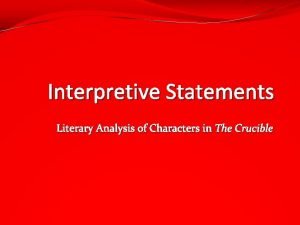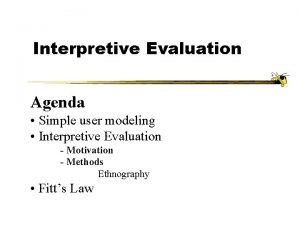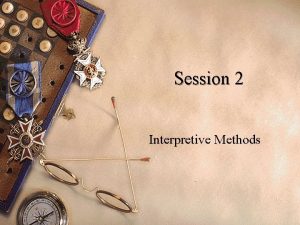Interpretive Statements Literary Analysis of Characters in The







- Slides: 7

Interpretive Statements Literary Analysis of Characters in The Crucible

Create an Interpretive Statement 1. Refer to your SATDO Interpretation Chart 2. Choose an entry 3. Combine the textual evidence (quotation) with the interpretation of that textual evidence into one or more sentences. 4. Be sure to correctly embed/integrate the quotation, utilizing your own words as well as the quoted material. The quotation can NEVER be the whole sentence!

If you know the Jane Schaffer Method… Chunk=smallest unit of writing Concrete detail— 1 sentence Commentary— 2 sentences or more Interpretive statements are “chunks”

Remember! �Each statement should be meaningful and NOT repetitious �The quotation should flow smoothly with the rest of the text �You must correctly cite the quotation (include page number) �Double check your punctuation

Example #1 SATDO Evidence Interpretation Rationale “John, if it were not Abigail you must go to hurt, would you falter now? I think not” (57). Elizabeth thinks that John still has feelings for Abigail and that is why he doesn’t want to report her as a fraud to the court in Salem. Elizabeth’s insecurity drives the plot forward. Her doubt angers Proctor and may very well be what propels him to action. Interpretive Statement: Because John fails to report his knowledge of Abigail’s fraudulent charges of witchcraft, Elizabeth says, “If it were not Abigail you must go to hurt, would you falter now? I think not” (57). This shows that Elizabeth believes John still has feelings for Abigail. Feeling insecure in her marriage may make her lonely and isolated, while demonstrating the insecurity angers John and intensifies the conflict present in their relationship, which is essential to the plot.

Example #2 SATDO Evidence Interpretation Rationale “I think, maybe, we have been too hard with Mr. Parris. I think so. But sure we never loved the Devil here” (70). John, as well as Elizabeth Proctor, were not pleased with Reverend Parris’ preaching style and attitudes. Puritan belief forces them to honor the Reverend as a man of God, despite personal differences. The Proctors set themselves apart by separating religious belief and church participation. Interpretive Statement: John has made it clear that he disagrees with Reverend Parris’ preaching style and attitudes, and Elizabeth aligns herself with her husband: “I think, maybe, we have been too hard with Mr. Parris” (70). This is significant because Puritan belief requires church attendance; the Proctors would be considered rebellious for making judgments on an ordained Reverend.

Example #3 SATDO Evidence Interpretation Rationale “I cannot think the Devil may own a woman’s soul, Mr. Hale, when she keeps an upright way, as I have…. if you believe I may do only good work in the world, and yet be secretly bound to Satan, then I must tell you, sir, I do not believe it” (74). Elizabeth indicates disbelief in the accusations of witchcraft, especially since she is accused and strives to be a good person. Puritans believed in the Bible as the ultimate authority. Since the Bible says there are witches, “the devil is a wily one, ” and even that Lucifer was beautiful before his fall, it is easy for them to believe anyone could become possessed. This statement sets Elizabeth apart from the Puritan ministers. Interpretive Statement: Hale is alarmed when Elizabeth admits that she does not think a person can behave in “an upright way” and simultaneously be “bound to Satan” (74). To Hale, Elizabeth appears to be contradicting the established authority of the Bible. From his perspective, this puts her Christian goodness in question and enables him to proceed with the investigation.













